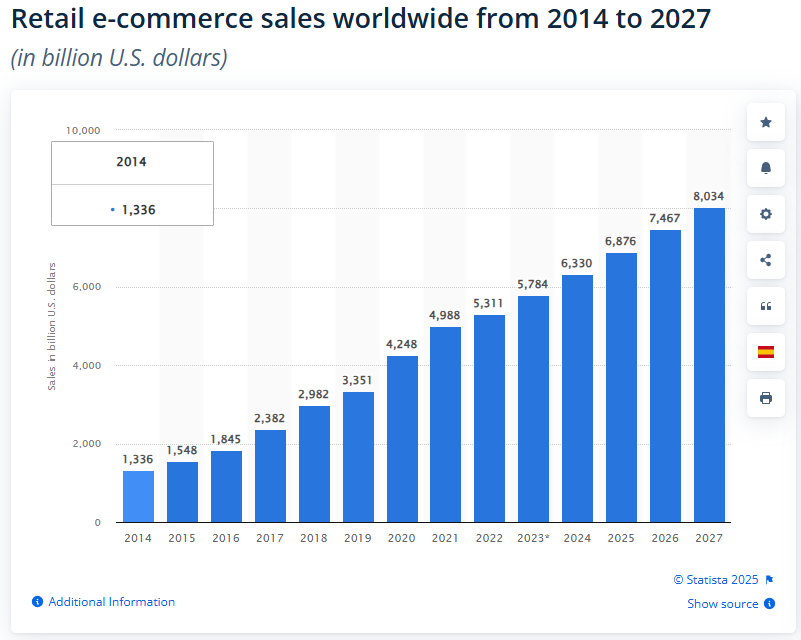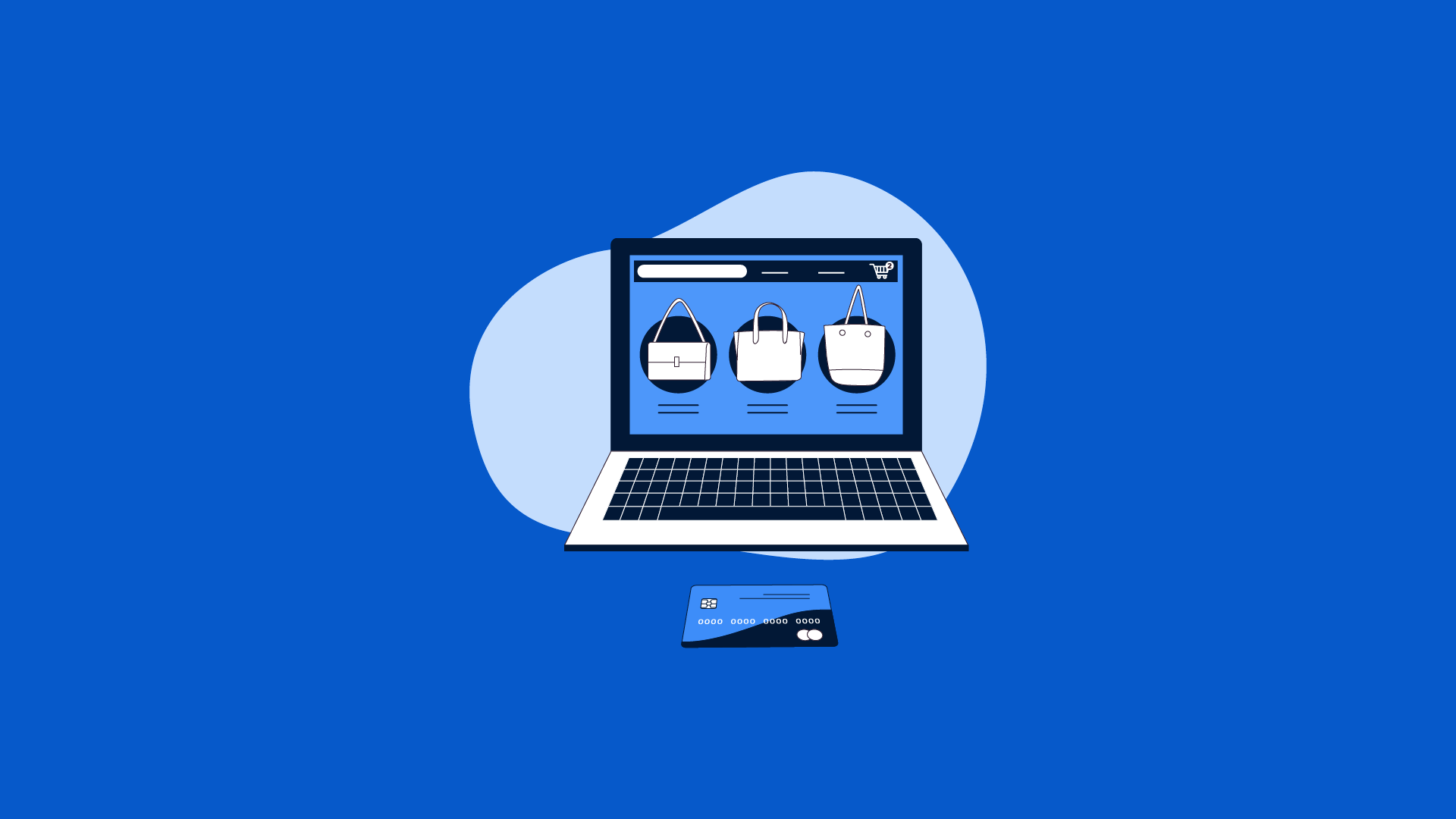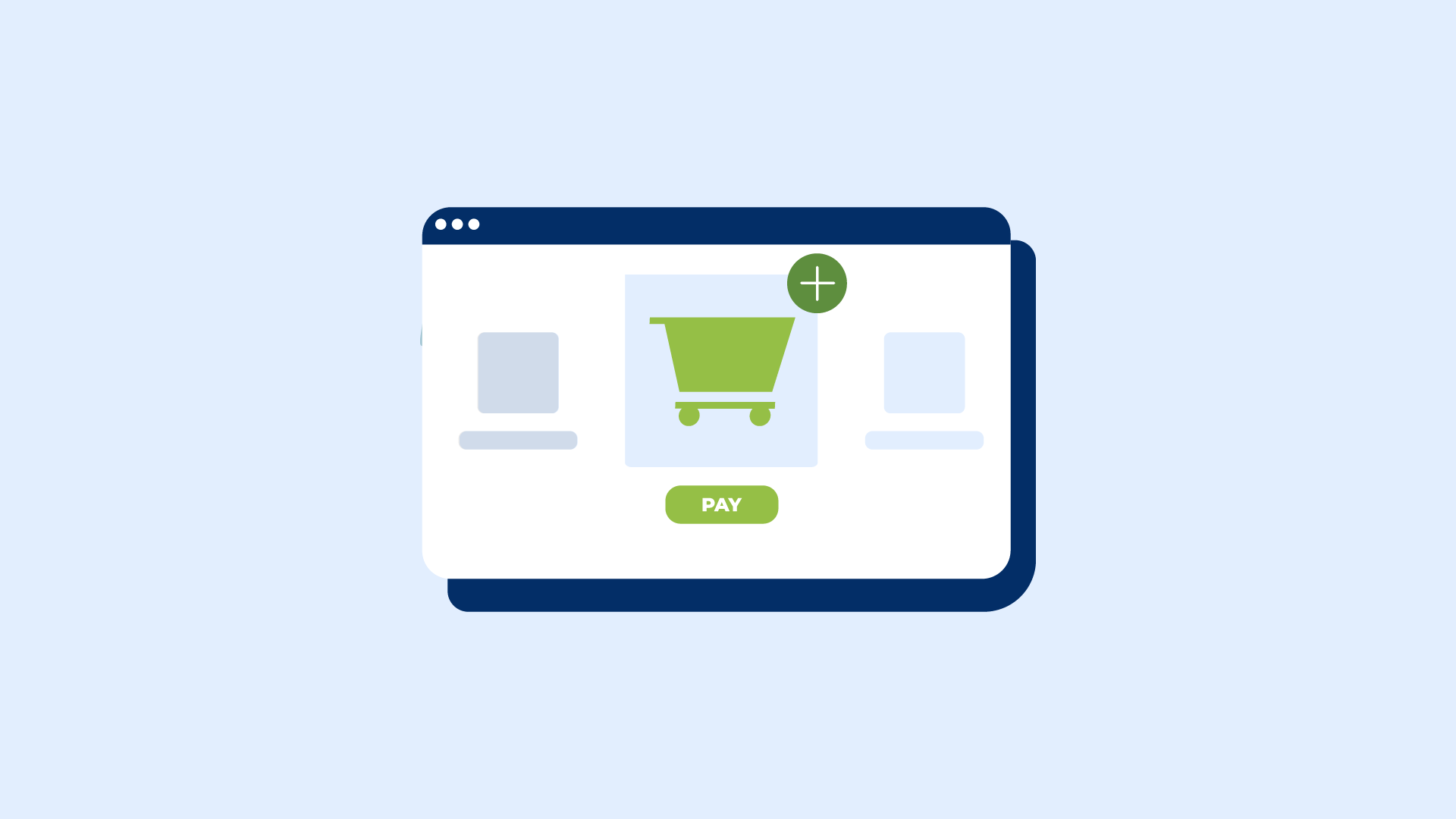With the global ecommerce market reaching $8.09 trillion by 2028, this industry is continuing to expand rapidly. This expansion is influenced by the need to accommodate consumer needs and wants, and the increasing role of ecommerce platforms in facilitating online shopping.
And while ecommerce sales are expected to continue growing 8% annually through 2025, many brands struggle with how to keep up with consumer demands and expectations.
That’s why we’ve rounded up the best sources of general ecommerce statistics for your brand. From supply chain and logistics to consumer trends and mobile shopping statistics, use this resource as a guide to better understand the ecommerce landscape and how it affects your business.
By 2021, global retail ecommerce sales will reach $4.9 trillion. (Statista)
Global retail ecommerce sales are expected to grow 15% in 2020 over 2019 levels. (Emarketer)
The number of digital buyers worldwide will increase from 1.92 billion in 2019 to 2.14 billion in 2021. (Statista)
52% of all internet users worldwide have made an online purchase in the past year. (Global Web Index)
Global Ecommerce Overview
The global ecommerce market has experienced rapid growth in recent years, with online sales reaching an estimated $6.03 trillion in 2024.
This impressive figure is expected to grow by 39% over the next four years, reaching a staggering $8 trillion by 2027. Leading the charge in ecommerce sales is the Asia Pacific region, which surpassed $3.3 trillion in 2022.
Not far behind, the United States, China, and the United Kingdom also rank among the top ecommerce markets globally. This explosive growth underscores the increasing reliance on online shopping and the vast potential for businesses to tap into the global ecommerce market.
Ecommerce Spending and Global Ecommerce Sales Statistics
Ecommerce continues to gain ground. Though online sales still make up less than 10% of total US retail sales, ecommerce is growing faster than any other retail sales channel. In fact, we forecast it will grow 16.1% this year and continue to accelerate through 2022.
As more consumers get comfortable with buying goods and services online, they’ll spend more time making online purchases on their desktop computers, and mobile devices.
Tech-savvy consumers looking for quick, seamless purchasing options will continue to lean on ecommerce throughout the next few years—and more consumers will jump on the bandwagon.
Insider Intelligence expects US retail e commerce sales will grow 16.1%, reaching $1.06 trillion in 2022. That steady growth will be driven by Americans of all ages, but millennials in particular have been early adopters of ecommerce.
They spent an above average revenue of $2,484 online in 2018, which is about $400 more than the average US adult spent during the same period.

Statisa predicts a global online sales to reach 6.87 trillion in 2025.
In 2014, global e-commerce sales stood at $1.336 trillion.
By 2023, sales had quadrupled, reaching approximately $5.784 trillion.
The projected figures for 2025 are $6.876 trillion, with further growth to $8.034 trillion by 2027.
Between 2014 and 2019, sales nearly tripled, growing by $2.912 trillion.
Between 2020 and 2025, sales are expected to rise by over $2.628 trillion.
The ecommerce sector’s share in the US retail market increased from 13% in 2018 to 14.2% in 2019. By 2022, ecommerce is expected to make up 17.5% of total retail sales.
The Indian ecommerce market is expected to grow to $111.4 billion by 2025, up from $46.2 billion in 2020.
Global E-commerce Growth
The e-commerce sector has experienced significant growth over the past few years. In 2021, global e-commerce sales were approximately $4.98 trillion, increasing to $5.82 trillion in 2023.
Projections indicate that this upward trend will continue, with sales expected to reach $6.86 trillion in 2025 dollars worldwide and potentially surpass $8 trillion by 2027.
Ecommerce Consumer Behavior Statistics of Online Shoppers
Consumers, particularly online shoppers, have increasingly turned to ecommerce since 2020. And with this shift in behavior comes a new set of challenges for brands and online retail businesses.
As the year has progressed, however, many online retailers have managed to increase inventory. Also, to streamline shipping and delivery times, and stay competitive. This is great news for shoppers who are relying on the convenience of ecommerce now more than ever.
But it’s not just about convenience. Online shopping offers an opportunity for superior customer service through chatbots and AI-powered tools. It provides a consistent experience from any device. And the ability to personalize recommendations can even lead to better shopping decisions.
Consumer preferences continue to evolve, with 52% of online shoppers willing to purchase products from international retailers. Additionally, 34% of consumers shop online at least once a week, and a significant 99% seek out reviews before making online purchases.
The most popular online shopping categories include consumer electronics, fashion, and food and beverages, with estimated spending in 2025 reaching $922.5 billion, $760 billion, and $708.8 billion, respectively.
Consumer electronics have seen a significant surge in online sales, with many shoppers preferring to purchase these products online through ecommerce platforms.
Still, there are certain challenges that come along with online shopping. For example, not being able to try on clothes in a fitting room. This is why it’s important for retailers to prioritize unique experiences that compensate for this loss of physical interaction.
Here are some statistics about ecommerce consumer behavior that can help you understand your customers’ needs better and improve your overall strategy.
One of the most shocking findings from 2020 was how much money consumers spent online. Even with large parts of the economy shut down or severely limited, ecommerce spending reached $861 billion by the third quarter to October 2020. This is an increase of 35% over 2019 figures.
In 2020, 84% of consumers shopped online more than before.
It’s not just fashion and luxury retailers, either. In May, Walmart reported a 97% increase in online sales!
According to Linnworks’ study, 76% of consumers value convenience as one of their top priorities.
78% of consumers now value convenience more than they did before COVID restrictions.
About 70% of consumers now shop while multitasking. (for example, while scrolling social media platforms).
Simplicity of payment options drives 89% of consumers to make buying decisions quickly.
The COVID-19 pandemic cause a significant change on ecommerce revenue trends around the world. This is because brick-and-mortar stores are shuttering overnight.
This has resulted in shoppers flocking the to the internet to buy their goods and consumables. Experts say the pandemic accelerated the shift to online shopping by as much as five years.
Since mobile internet usage is higher than desktop internet usage, it makes sense that more people are turning to their phones to shop online.
Mobile devices are the most frequently used devices for online shopping.
More than 60% of US digital buyers have made a purchase on a mobile device within the past year.
And more than 90% have used a mobile device to research products or services.
According to Shopify, mobile shopping from their merchants captured 71% of online sales via mobile over Black Friday Cyber Monday.
An estimated 10 billion mobile-connected devices are currently in use.
Three out of four consumers say they purchase on their mobile devices because it saves them time. (ThriveMyWay)
More than half of shoppers say they would like online retailers to provide more product reviews and information. (ThriveMyWay)
As many as 90% of shoppers say their experiences with mobile commerce could be better.
Two of the biggest concerns hindering mobile shopping are links that are too small to click and security issues.(ThriveMyWay)
Online Shopping Trends
Most shopping journeys start online
In today’s digital age, a significant 85% of online shoppers begin their shopping journey on social media platforms or search engines before making a purchase. This trend underscores the importance of having a strong online presence across various digital channels. Interestingly, 44% of shoppers start their search on search engines, while 41% head directly to online stores like Amazon or a business’s website. Social media platforms also play a crucial role, with 14% of people starting their shopping journey there. This highlights the need for businesses to optimize their presence on social media platforms to capture the attention of potential customers right from the start.
Online consumers will spend the most on electronics this year
Consumer electronics are set to dominate online shopping this year, with an expected $922.5 billion in sales. This makes it the top category for online spending, reflecting the growing trend of consumers turning to ecommerce platforms for their tech needs. Fashion follows as the second-largest category, with an estimated $760 billion in total sales made, while the food and beverages sector is expected to see $708.8 billion in cumulative spending. These figures not only highlight the popularity of online shopping for consumer electronics but also underscore the significant market potential in other popular categories.
Mobile Ecommerce Statistics
Mobile devices have become an indispensable part of the ecommerce landscape, with 44.2% of all ecommerce sales in the United States coming from mobile purchases.
It’s no surprise that three out of four consumers say they shop from their phones, and 65% of shoppers look up price comparisons on their mobile devices while browsing in physical stores. However, a subpar mobile experience can erode trust in a company, with 52% of users expressing that it affects their confidence.
To the mobile audience and provide a seamless mobile experience, ecommerce businesses must ensure that their websites are optimized for mobile devices. In fact, 85% of users expect a mobile experience to match the quality of a desktop encounter, making mobile optimization a critical factor for success in the ecommerce market.
Social Commerce Statistics
Social media platforms have become a crucial channel for ecommerce businesses, with 87% of sellers reporting that social selling has been effective for their business.
Platforms like Facebook, Instagram, and YouTube are the most commonly used for social selling, with 68% of social media marketers using these platforms to drive traffic to products on their own websites.
Social media platforms offer a range of features that enable businesses to sell products directly to customers, including Instagram Shopping and Facebook Marketplace.
By leveraging these features, ecommerce businesses can increase their online sales and reach a wider audience, making social commerce an essential component of a successful ecommerce strategy.
Ecommerce Market Share
The ecommerce market is highly competitive, with numerous players vying for market share. Amazon stands as the largest ecommerce company worldwide, boasting a market cap of over $1.3 trillion.
eBay follows as the second-largest ecommerce company, with a monthly average of 589 million visitors. Other major players in the ecommerce market include Shopify, WooCommerce, and Magento.
To succeed in this competitive landscape, businesses must differentiate themselves in store front through unique products, competitive pricing, and exceptional customer service. By focusing on these key areas, ecommerce businesses can carve out a niche and thrive in the bustling ecommerce market.
Consumer Trust and Data
Consumer trust is a critical factor in ecommerce, with 19% of consumers expressing that they do not trust ecommerce websites with their credit card information. To build trust, ecommerce businesses must ensure that their websites are secure.
Interestingly, 42% of consumers trust social media platforms with their personal card information. Transparency about data collection practices is also essential, as 47% of consumers are concerned about how their data is used.
By prioritizing consumer trust and data security, ecommerce businesses can build a loyal customer base and drive long-term growth. Ensuring secure transactions and transparent data practices will be key to maintaining consumer confidence in the ever-evolving ecommerce landscape.
Regional Insights
China leads the global e-commerce market, with over 904 million online shoppers contributing to more than $3 trillion in annual sales.
The United States follows, with 288 million online buyers and e-commerce sales projected to reach $1.26 trillion by the end of 2024. Notably, the U.S. e-commerce market has grown by more sales 330% over the past decade, from $260.4 billion in 2013 to $1.12 trillion in 2023.
E-commerce Platforms and Marketplaces
The digital marketplace is supported by over 28 million e-commerce sites globally, with the United States hosting approximately 50% of these platforms.
Shopify and Wix are prominent players, powering 29% and 20% of online stores, respectively. Amazon maintains a dominant position in the U.S. online marketplaces alone, holding a 37.6% share, followed by Walmart at 6.4%.
Checkout and Payment
The average checkout process on eCommerce sites spans 5.08 steps
The average checkout process on eCommerce sites consists of 5.08 steps, which can be a significant barrier to completing a purchase. This lengthy process contributes to a high 22% cart abandonment rate, as customers often get deterred from finalizing their purchases. Streamlining the checkout process and reducing the number of steps can help improve conversion rates and reduce cart abandonment. By simplifying the checkout experience, businesses can enhance customer satisfaction and drive more successful transactions, ultimately boosting their overall ecommerce sales.
Future Projections of the Ecommerce Market
Looking ahead, e-commerce is expected to account for 22.6% of all retail purchases by 2027, reflecting an average annual growth rate of 0.32% since 2021. This sustained expansion in internet penetration underscores the increasing importance of a robust online presence for businesses aiming to remain competitive in the evolving retail landscape.
The e-commerce industry in 2025 is characterized by significant growth, technological advancements, and shifting consumer behaviors. Businesses that adapt to these changes by enhancing their already powerful online sales platforms, offering diverse product categories, and prioritizing customer experience are well-positioned to thrive in this dynamic environment.
Frequently Asked Questions (FAQ) About Ecommerce Statistics
What is the current size of the global ecommerce market?
The global ecommerce market is projected to reach $6.3 trillion by 2024, showcasing the rapid expansion and growing significance of online shopping in the global economy.
How much of total retail sales are made up by ecommerce?
Ecommerce currently accounts for a significant portion of total retail sales, with projections indicating it will make up 22.6% by 2027. This reflects the increasing preference for online shopping among consumers worldwide.
Which are the most popular ecommerce platforms?
Some of the most popular ecommerce platforms include Amazon, Shopify, and WooCommerce. These platforms are widely used by businesses to make brand websites, reach customers worldwide and facilitate online sales.
What role do mobile devices play in ecommerce?
Mobile devices are crucial in ecommerce, with a significant portion of online shopping orders being placed through mobile commerce. Consumers frequently use their mobile devices to shop online, compare prices, and make purchases on the go.
How are social media platforms influencing ecommerce?
Social media platforms play a significant role in ecommerce by driving traffic to online stores and enabling social commerce. Features like Instagram Shopping and Facebook Marketplace allow businesses to sell directly to consumers through these platforms.
What are some key consumer trends in ecommerce?
Key consumer trends include a growing preference for convenience, personalized shopping experiences, and the use of mobile devices for online purchases. Consumers are also increasingly looking for social proof, such as reviews, before making buying decisions.
How can businesses increase their ecommerce sales?
Businesses can increase sales by optimizing their online platforms for mobile devices, enhancing customer engagement through social media channels, and offering seamless checkout experiences. Additionally, leveraging data analytics and AI can help personalize shopping experiences and boost sales.







